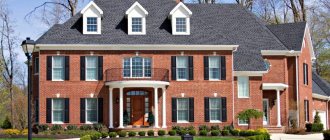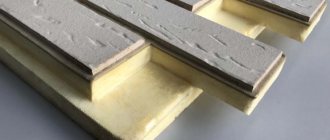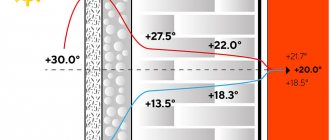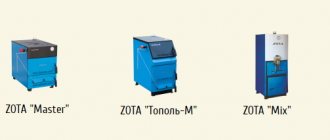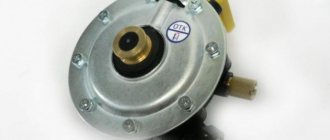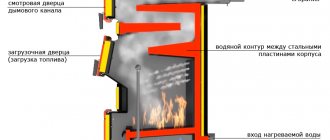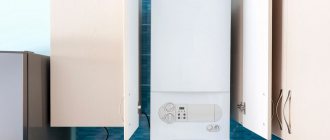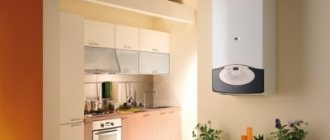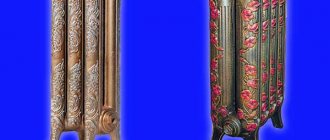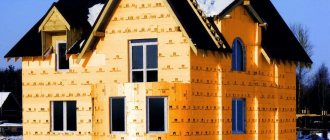The topic of the article is panels for insulating the facade of a house. Having appeared on the modern building materials market, heat-insulating decorative panels have not gained much popularity. The reason is the higher price than time-tested old technologies. But this material did not leave the market, like many innovations on which manufacturers pinned their hopes. So, in this article we will deal with panels for insulating and decorating the external walls of buildings, what materials they are made from, and what methods they use during installation.
The facade of the house, finished with decorative panels with insulation Source blogremonta.com
What is a thermal panel for the facade of a house and their characteristics
Thermal panel is a special plate made of several layers: an insulating layer, an insulating layer and a decorative one.
Also, panels can be simple two-layer and complex three-layer. A two-layer board consists of insulation and facing material, which is attached with glue. In three-layer slabs, in front of the insulation there is a layer of oriented strand boards, which adds additional tightness. Some models of three-layer slabs are equipped with special metal inserts, which facilitate the installation process and increase strength.
This design allows for excellent heat retention and moisture retention. However, the materials from which thermal panels are made have pores and will allow the house not to overheat in the warm season.
When insulating the outside of a house with thermal panels, you should pay attention to the insulation. Cheaper models use foam and mineral wool as insulation. And in more expensive ones there is extruded polystyrene foam and polyurethane foam.
Experts recommend using the last two types, as they have proven themselves to be durable and very dense materials. Polyurethane foam is an innovative material with high density (60 kg per cubic meter) and low thermal conductivity.
It is virtually unaffected by extreme weather conditions and is resistant to moisture. Also, it tolerates temperatures from 160 to + 140 degrees. Its service life is at least 50 years. Polystyrene is a cheaper option. It is less dense, compared to polyurethane foam, and is more resistant to weather conditions and moisture.
Its service life is 10-15 years. However, these two materials are excellent for insulating the exterior of a house with thermal panels. The key difference is cost. Panels based on polyurethane foam are more expensive.
The choice of material must be made wisely, based primarily on climatic conditions. Polyurethane foam is more suitable for harsh climates, and polystyrene foam for moderate ones. A wise choice will allow you to save a little.
Features of the design of panels with insulation
Common to all types of thermal panels is the presence of at least two layers: an external decorative coating and an internal thermal insulation layer . Decorative coating performs the same functions as classic façade panels: protection from mechanical damage and from the effects of wind and moisture, giving the walls a complete appearance.
IMPORTANT!
There are three-layer versions of products called sandwich panels. In them, the thermal insulation material is located between two facing layers made of metal.
For operation in conditions of increased fire hazard, four-layer thermal panels are produced, in which there is a fire-resistant material between the outer tiles and the insulation.
The main stages of production of insulated products with decorative coating : preparation of block molds, foaming and drying of insulation granules, laying a decorative layer in a block mold, adding granules, heating the structure with hot steam (necessary for the granules to expand and form a layer of insulation), cooling panels.
The main purpose of using warm panels is to save on heating the building , allowing you to recoup the costs of their purchase and installation in the shortest possible time, provided that the house is located in a region with relatively cold winters. They are more expensive than conventional panels, but in most cases you will have to spend even more money purchasing siding and insulation separately (and installing them).
The products can be installed on most plastered and unplastered surfaces, including block and wooden walls, adobe brick, and expanded clay concrete.
NOTE!
Thermal panels not only retain heat inside the building during the cold season, but also prevent it from heating up in the summer.
Decorative finishing is made from the following materials:
- Clinker.
- Porcelain tiles.
- Aluminum.
- Cink Steel.
- Compressed wood chips.
- Pressed marble chips.
The main insulation materials are polyurethane foam, mineral wool, and expanded polystyrene foam. The average density of this layer is 40 kg3/m, thermal conductivity is 0.020 W/m*C, thickness is 6 centimeters or more.
The high density of the material not only allows for better heat retention, but also increases its resistance to mechanical damage. The operating temperature range is between – 170 / +170 C. Despite the high fire resistance, the possibility of fire of the insulation is not completely excluded.
The weight of the panels varies between 10-25 kilograms . The approximate service life depends on the climatic conditions of the region, as a rule, it is 10-30 years.
What are the advantages of facing material?
Advantages of facade thermal panels:
A wide selection of thermal panels makes it possible to make any façade unique
- There are no restrictions on the use of heat finishing. The material is used for covering brick, concrete, plastered and unplastered walls. If the geometry of the working surface is damaged, a sheathing is installed before installation work.
- Installation can be performed at any time of the year and in any weather.
- Considering that the façade thermal panel is responsible for heat retention and the appearance of the room, it can be safely attributed to multifunctional materials.
- Together with façade thermal panels, you can make any design fantasy come true, since the finishing has a huge variety of shapes and shades.
- Thanks to excellent thermal conductivity, insulating a house with thermal panels will allow you to significantly save on heating costs in winter.
- The environmental friendliness of the material allows the use of thermal panels for interior decoration.
- The cladding is durable. With proper installation work, the cladding can last up to 50 years without interruption.
- Wall decoration does not require periodic repair work, as is the case with foam plastic.
- The decorative layer protects the entire structure from mold, mildew, and corrosion.
- The light weight of the material eliminates the need to strengthen the existing foundation.
- Installation of thermal panels can be done with your own hands without the involvement of professional force.
Calculate the insulation of your home
There is one rule that is better not to break - insulation of the walls of the house should be done on the outside of the walls. Here another question arises: what insulation is better to use, and in what quantity, in order to achieve the maximum effect. The answers to the questions asked depend on the following criteria:
1.What are the climate parameters in this region.
2.What conditions apply to the microclimatic conditions inside the house.
3.What materials and with what density will be used when performing insulation.
In reality, the selection of insulation and its thickness must be determined based on the results of rather complex thermal calculations. Practice shows that it will be better if they are carried out by a specialist.
Many companies that deal with home insulation have such an employee on their staff. If all the work is entrusted to such a company, then the calculation of materials is included in the price. Those who decided to install insulation with thermal panels, polystyrene foam or mineral wool with their own hands can use online calculators. They are usually located on the websites of construction and repair companies.
Types of thermal panels
There is a huge selection of thermal panels made from different facing materials. Popular materials are clinker tiles, plastic, ceramics and metal sheets. There are also thermal panels lined with decorative plaster.
Thermal panels lined with clinker tiles are suitable for lovers of brickwork. These panels have a long service life and good resistance to moisture. This type of thermal panels can only be mounted on flat walls.
Plastic thermal panels are a more budget option. They are suitable for insulating a store or warehouse. Conveniently installed, similar to siding.
Ceramics and porcelain tiles have proven themselves among lovers of stone houses, as they allow them to imitate any texture of stone. They are environmentally friendly and breathable.
Metal panels are an excellent solution for cities with harsh weather conditions. The metal sheets are treated with an aluminum-zinc coating, which ensures their durability combined with excellent thermal insulation properties.
Panels with decorative plaster are usually made of polystyrene foam and marble chips. They are installed using glue.
Such a large selection is due to the different desires of customers. You can choose a material that attracts you visually and matches the style of your home.
Foam plastic in the interior and on the facade
Buildings with facades decorated with foam plastic are exclusive and romantic. The upper part of the wall of the house with decoration in the form of an entablature adds mystery, the columns with a figured capital turn the house into a real classical structure, and the arched doorway framed by a decorative archivolt completes the overall bright impression.
For interior decoration, stucco foam is used on the ceiling and walls. Any modern solution is appropriate in the ceiling design. The decoration around the chandelier and illuminated cornice moldings look attractive. The wall decor assumes a classic style.
So, decorating a house or apartment with polystyrene foam is quite accessible, inexpensive and practical. Working with him, you can discover your talents as a designer and subsequently be proud of your own achievements.
https://youtube.com/watch?v=T_LkShpDoOc
Product categories
Product categories
Details about the composition of thermal panels
What are thermal panels usually made of? There are two varieties - two-layer and three-layer. Let's look at them in order.
Double-layer panels
Double-layer panels are an affordable type of such material. It is based on extruded polystyrene foam, on top of which decorative elements are glued. It is the insulating part that gives rigidity to the entire structure.
Double-layer thermal panel based on polystyrene foam
This material has the following properties. Service life is 10-15 years (again, provided there is no external influence). The material is not resistant to aggressive environments, which can cause it to deform.
Flammable - when ignited, the flame spreads very quickly and produces a lot of acrid smoke.
Such panels should only be used for installation on a flat base, since their rigidity is not enough for installation on a frame.
Three-layer panels
We actually described three-layer thermal panels when we talked about the advantages of this material. At the base they have an OSB panel, which significantly increases the strength of the material as a whole. In the middle there is a layer of polyurethane foam - this material is also quite strong and dense, along the entire perimeter of the panel there are locks formed on it, which were not there in the previous version - this structure allows you to avoid the appearance of cold bridges. The insulating properties of such panels are higher than those of their analogues.
Structure of three-layer thermal panel
Finishing layer
Both panels have a finishing layer. Usually this is clinker, which, by the way, can be glazed, or polymer elements made mainly of acrylic. Both options have a long service life, easily withstand weather conditions and look beautiful, however, clinker still looks more natural and richer, which is why it costs much more.
Also, artificial stone, ceramics, porcelain stoneware, plastic, metal, and sometimes wood are used as materials for the front side of the panel. The latter panels are very rare and difficult to find for sale. Models for decorative plaster, the role of which is played by glued marble chips, look interesting.
We recommend: How to close windows from the sun: methods of complete shading and easy protection from the sun's rays with your own hands
Variety of appearance of facade thermal panels
Interesting to know! To seal the seams between the panels under plaster, a special paste is used, the same color as the panels themselves. If you don’t look closely, you get a completely monolithic surface.
Table for choosing thermal insulation depending on the type of facade system
| Type of facade system | Recommended materials |
| Plaster facade | Rigid stone wool slabs with a density of 120 kg/m3, polystyrene foam grades 15N, 20N, 25N, extruded polystyrene foam with a density of 26-32 kg/m3. |
| Hinged ventilated facade | Non-flammable rigid slabs with a windproof layer with a density of 90 kg/m3 and higher. |
| Siding | Polystyrene foam with a density of 10, 15, 20 (except for a log house), lightweight thermal insulation boards and mineral wool mats with a density of 75 kg/m3. |
How to choose?
There are many façade systems for exterior finishing with insulation to choose from. It depends on the type and scale of the building, planning requirements, which may affect the appearance of neighboring buildings.
Panel structures include structural members that provide lateral and vertical resistance to wind and other environmental influences, as well as wraparound parts that provide weather resistance, as well as thermal, acoustic, and fire resistance properties.
This product allows you to change the appearance of a building in various ways. The variety makes timber house panels an innovative option for architects. There is a wide range of different formats and installation options that create a completely different character for the building.
The gaps provided between the panels allow the façade to act as a ventilation system that retains moisture. Double tempered acrylic resins provide effective weather protection suitable for balconies and cladding. Other properties include optimal light fastness, double hardening, scratch and solvent resistance, impact resistance, and frost resistance. The product is manufactured in laminate presses under high pressure and temperature.
When choosing products, you should pay attention to the features of different models. The manufactured stone-look product will please you with its respectable appearance, but it is highly expensive.
There is a wide variety of panels on the market that qualitatively imitate wood texture. They are ideal for small houses, cottages, where you want to create a special coziness.
If you choose a brick model, then such material will resemble real brickwork not only in appearance, but also in texture. It is not so easy to distinguish from the original.
In order not to be disappointed in this type of finishing, it is better to always choose a panel with insulation for exterior finishing. It is suitable even for a wooden house, the only difference is in the installation method.
Distinctive features of foam decoration
Foam decorations for facades are produced by pouring into special molds.
Attention! When installing foam plastic products on the facade of a house, it is necessary to use a special protective coating. It is necessary to increase the resistance of foam plastic products to external negative influences, increase its strength, and extend its service life.
It is necessary to increase the resistance of foam plastic products to external negative influences, increase its strength, and extend its service life.
There are many reasons why ordinary buyers should purchase decorative elements made of foam plastic.
Manufacturers offer facade decorative elements in a different color range, and at very affordable prices.
Polystyrene foam does not have high reliability, mechanical resistance, or durability, but with the help of modern technologies all these minor shortcomings can be easily eliminated.
Advice! Facade decor made of expanded polystyrene (foam) without additional processing is appropriate only in places that are reliably protected from the effects of the environment.
For example, you can use façade elements made of foam plastic to decorate the cornice, which is located under the roof slope. This area is reliably protected from moisture, and the material is not at risk of mechanical damage.
The facade decor made of polystyrene foam, made in the form of arches, must be treated so that weather conditions do not spoil its appearance. Sometimes decorative elements made of polystyrene foam are used in conjunction with other materials that will allow the decoration to be used for much longer.
Among the recent fashion trends, we note the option of non-standard decoration of the external walls of a private house.
Foam plastic decor for facades is lightweight and easy to process, which is why the material is in demand among architects. It is the decor made of foam plastic that allows the owners of country cottages to turn original design ideas into reality.
How to prepare?
Polymer finishing on the outside of walls is installed using frame technology. The main thing is to correctly install the sheathing, which in most cases is made of wooden blocks, and sometimes of aluminum profiles.
The construction of the frame is the main preparation of the wall, if it is smooth. If this condition is not met, then the preliminary work on organizing the cladding comes down to additional processing and leveling the surface.
The first profile must be installed perpendicular to the ground, at a point that is considered the lowest at the facade. This is the so-called starting bar. The remaining horizontal elements are attached 50 centimeters from it.
Fastening is carried out using self-tapping screws and dowels. Now you can install the vertical guides.
Distinctive characteristics of foam decorative elements
The decor of the facade of a polystyrene foam house has some distinctive characteristics:
- affordable price of products;
- ease and speed of installation of finished products;
- the possibility of decoration without the involvement of specialists;
- minimum weight that does not lead to additional load on the foundation of the building;
- long operational service life;
- excellent water-repellent characteristics;
- increased strength;
- environmental friendliness and resistance to decay processes
Installation work associated with the use of polymer makes it possible to carry out installation in any climatic conditions, regardless of temperature indicators.
Calculations
To understand what the need for a building material is, it is necessary to find the total surface area. From the resulting value, the sum of the area of doors and windows is subtracted and 10% is added, which is taken away by cuts and overlaps during the work. The resulting figure is divided by 4.55, which is exactly how many square meters. m is in one package of plates.
The amount of required starting strip for insulating panels is calculated based on the perimeter of the building. The width of the doors is subtracted from the resulting value and divided by 3. To avoid mistakes, add 5% of the resulting number.
External angles are determined by the sum of the heights divided by 0.45 m. To be correct, it is worth adding 5% of the obtained value.
One panel requires 5 fasteners, the corner element takes 4, and the curb takes 2. Fastening the starting strip requires at least 10 elements if the fastening is made after 30 centimeters.
When making calculations, it is worth taking into account not only the area of the walls to be covered, but also heat loss , according to which in the future the material of the required thickness will be selected.
- The U-value is a measure of how much heat is lost through a given thickness of a particular material, but includes the three main ways in which heat loss occurs - conduction, convection and radiation. This is a measure that always applies in the Building Regulations. The lower the U-value, the better the material is as a thermal insulator. The U-value provides insight into the consequences that thermal performance has when aimed at meeting current building codes.
- The R-value is a measure of the resistance to heat flow through a given thickness of material. Thus, the higher the R-value, the higher the heat resistance of the material and, therefore, the better its insulating properties. Heat moves in and out of a building in several different ways, and the R value only takes into account conduction and does not include either convection or radiation.
Wall condition assessment
Before purchasing the required amount of materials, you should carefully “diagnosticize” the walls of the house - they may need minor repairs or leveling using a subsystem.
In order for the panels to be securely attached to the facade, there should be no weak spots on the walls - peeling of old plaster, karst depressions, deep cracks, loose areas, etc. - everything that will not allow you to reliably strengthen the dowels.
If necessary, minor repair work will be required.
The evenness of the walls is assessed – vertically, horizontally and diagonally.
Thermal panels can be mounted directly on the facade if local level differences do not exceed 50 mm.
In cases where small bulges in the wall can be eliminated, this should be done in advance. If the differences are significant, and their elimination will involve large-scale plastering work, it will be easier to level the level using lathing.
Surface preparation
An important stage is the preparation of the walls. Before installing thermal plates, it is necessary to carefully work on uneven surfaces. First of all, the wall is treated with a primer. This will provide an excellent surface for the adhesive to apply and will further ensure a seal.
It is recommended to use a coarse primer. All minor irregularities are additionally treated with polyurethane foam. Next, proceed to the actual installation.
Popular methods of insulating facades
Modern builders use various methods of external wall insulation. Each method has its pros and cons. The “wet facade” technology has become a very popular method, what is its specificity:
- The wall is pre-cleaned and prepared.
- The next step is to apply a layer of glue of a maximum of three centimeters.
- Laying insulation.
- Applying another adhesive layer.
- Installation of reinforcing mesh.
- Applying plaster.
- Primer.
- Coloring.
Installation of an insulator under plaster is suitable for all types of mineral wool and foam plastic.
Features of installing thermal panels
You can install thermal panels yourself in several stages. First you need to take care of the tools that you will need for your work. It is recommended to prepare:
Cladding the façade of a building with thermal panels must be done using a level
- hacksaw;
- hammer;
- screwdriver;
- perforator;
- grinder;
- construction level;
- sealant;
- Master OK;
- pencil or marker for marking.
Algorithm for installing facade thermal panels:
- Pre-insulation solves the problem of unevenness on the walls. If necessary, install a sheathing. It should be noted that the best option involves attaching one panel to three adjacent vertical bars. The frame elements are treated with an antiseptic.
- Insulation with facade thermal panels begins from the corner of the house from bottom to top, moving from left to right. The lowest row rests on the starting bar, each subsequent row rests on the previous one. Docking occurs using a tongue-and-groove system to ensure maximum tightness.
IMPORTANT! The starting corner is mounted with the obligatory use of a level.
- Difficulties may arise when facing openings and corners if you do not use ready-made corner components. In the case of self-covering corners, the joining edges of the thermal panels are cut at 45°, and the resulting gap is masked with polyurethane foam.
IMPORTANT! Experts strongly recommend using fittings from the manufacturer, which guarantees maximum tightness.
Thermal panels for the facade are attached with special dowels
- Facade thermal panels are attached to the walls or frame with self-tapping screws or dowels. When the installation work is completed, they begin grouting the joints, which is preferably carried out in warm weather. It is estimated that about 3-5 kg of grouting agent should be used per 1 m² of cladding. Subsequently, the treated seams dry for two days.
- The final step is to treat the façade with a special agent to protect against moisture penetration.
We recommend: How to check a heating circulation pump: causes of malfunction
Installation of thermal panels
Thermal panels can be installed in two ways: with glue and with lathing. The first method is more preferable, since the glue will ensure a clear fit of the panel to the wall and will not leave any room for cold to pass through, but can only be used for smooth walls.
Before installing with glue, holes are made in the wall to additionally secure the thermal panels with dowels. Small irregularities can be removed using polyurethane foam or plywood lining. Next, a special adhesive mixture is applied to the wall and the panels are glued.
It is necessary to use special glue, since it is frost-resistant, moisture-resistant and has the necessary elasticity. After the glue has dried, usually one to two days, additional fixation is performed using dowels.
The joints between the plates are covered with glue to create even greater tightness. It is also recommended to treat the facade with a special hydrophobic solution. It is necessary for additional protection against water. Special substances in the solution simply will not allow water to be absorbed into the facing layer and will extend the life of thermal plates.
The panels are fixed to the frame if there are significant irregularities. This method is more complicated, since it is necessary to correctly build the sheathing. The material for construction is bars, preferably impregnated with antiseptic solutions, which will prevent rapid rotting of the wood.
First, the construction of the base frame and the installation of panels on it takes place. An important condition is to deepen the panels into the ground by 15-20 centimeters. Thermal panels are installed on the frame, starting from the corner and continuing upward.
Installation is carried out using self-tapping screws. Before installing the next row, it is necessary to carefully treat the gap between the thermal panels and the wall using polyurethane foam.
This action is very important and will ensure the tightness of the insulation. After installing all thermal panels, it is necessary to treat the seams using grout.
Nuances when installing façade foam plastic
Any construction process has its own nuances that must be observed. There are also special features for insulating the façade with polystyrene foam.
For example, if communications have not yet been connected to the house, before installing the insulation, it is necessary to mark their places with pipes or something else, so that when attaching the foam plastic, the dowel is not driven into the void or too close to the edge.
When working with polystyrene foam, it is worth remembering that all seams must be treated with polyurethane foam to prevent them from turning into cold bridges and moisture from getting inside. This is done even if the sheets were tightly fitted to each other.
Additional fixation of foam plastic with dowels is a necessary step when insulating, but when choosing fastening material it is important not to make a mistake. So, the length of the fastenings should be such that they have the opportunity to penetrate through the insulation layer and linger in the facade
For example, brick walls require a dowel length 9 cm longer than the foam layer, and concrete walls - 5 cm. The situation is most difficult with porous building materials, since it is quite difficult to bury fasteners in them. For this option, fungi are suitable, which can penetrate 12 cm into the base.
To avoid damage to the foam sheet, the dowels are not driven too deeply into the insulation. The optimal depth is 1 cm. To prevent the slab from cracking, the dowels are driven 20 cm from the edge.
To reliably strengthen a sheet of foam plastic, 5–6 pieces of fasteners are needed, and they should be located at approximately the same distance from each other. The glue on the back side should occupy approximately 50% of the total sheet area.
The main thing after insulating the facade is not to leave the foam for a long time without finishing cladding. Although this material is highly resistant to external influences, it can quickly become unusable from ultraviolet rays.
Seam processing
Once again, pay attention to the seams. For sealing, you can use grout or adhesive mixture. An adhesive mixture would be preferable, as it will ensure the tightness of the seam. Processing is carried out in the order of installation of the panels, that is, from bottom to top from the corner.
This order is necessary in order not to skip sections. Also, if you use thermal panels made of clinker tiles, it is possible to paint the seams between sections of brick.
A popular solution is a concrete mixture. It will give the appearance of a natural brick wall. However, you can use plaster or even paint. As I all know, small details give a house a certain “zest”.
Features of manufacturing foam decor
There are strict requirements for the polymer that is made for facade finishing of houses. The material for production is PSB 25f. It has all the most important characteristics and qualities in order to be used in exterior wall decoration. Thanks to modern automatic equipment, you can burn and cut contours, create products of different sizes and shapes. In order to achieve reliable protection of the created element from high humidity and sudden temperature changes, sheets of polymer material are coated with a reinforcing compound. For example, you can treat a sheet of polymer material with mineral mixtures created on the basis of acrylic paint.
Next, the sheet is sent for drying. In order for the polymer not to lose its technical and operational characteristics, it is necessary to withstand a certain temperature regime. As soon as the protective layer has dried, the workpiece is sent to the last stage of production: stripping and polishing.
Pros and cons of using thermal panels for a wooden house
Finishing the facade of a wooden house with thermal panels has certain advantages and disadvantages. The advantages include:
- Comfort during installation. The panels are light in weight and have a large area, which makes work faster. The material can be easily lifted to a height and cut. The panels have locking joints, which ensures easy joints and strength.
- The panels provide high-quality insulation of facades. Their use makes it possible to protect walls from freezing. It is possible to speak about the effectiveness of such insulation by comparing the type of insulation used.
- They are moisture resistant. But water can still penetrate under the finish if installation work is of poor quality.
- Low weight of panels. As a result, the walls of the building do not experience strong additional load.
- The decorative part of the material will not react to moisture. In fact, it does not absorb it, destruction does not occur under the influence of ultraviolet rays, which makes it possible to maintain its original appearance for a long time.
- Easy maintenance of thermal panels. There is no need for periodic processing and cleaning.
- A significant range of thermal panels. It is possible to choose options that imitate masonry made of brick, stone or logs.
Disadvantages of such products:
- Overpriced thermal panels. Compared to competitors, the difference in cost is 3 times. In this regard, it is advisable to make the walls thick with high-quality cladding.
- Duration of operation of thermal panels. The manufacturer indicates 50 years, which is possible with extremely careful use. It should be borne in mind that such deadlines are forecasts of marketers. The product appeared on the market about 10 years ago, so it was not possible to verify this judgment.
- For installation you will need flat walls or a leveled frame.
Styrofoam molding
Stucco molding is an accessible and inexpensive type of interior design. For centuries it was made from gypsum, but foam plastic, synthesized by chemists in the middle of the last century, won. It can imitate any architectural style.
Today you can buy cornices, columns, moldings (overhead convex strips), and other products for decoration made of granular or smooth polystyrene, unpainted or imitating wood, marble, stone.
Foam stucco cannot be called particularly durable. But it is ideal for those who like frequent repairs and in rooms with a non-standard microclimate: it is used to cover walls in a damp bathroom or basement, where other materials quickly deteriorate.
Types of thermal panels: which one to choose
There are different types of thermal panels. To make the right choice, you need to consider what they are.
Plastic
Made of plastic, due to the design of the air cells, heat is retained. Installation of such thermal panels is carried out by inserting products into one another. Plastic panels are moisture resistant and resistant to low temperatures. In addition, they can last for quite a long period.
The biggest disadvantage is that plastic will release toxic gases during combustion. Therefore, they are rarely used for residential premises, mainly for warehouses, change houses, etc.
Clay
Such thermal panels look extremely impressive when facing the facade. In addition to their appearance, they provide high-quality insulation to the home. Clay is moisture resistant and resistant to low temperatures. In addition, ceramic products will not lose their appearance due to solar radiation. They have high strength and durability.
Clinker
It is a multilayer material. There is only an option made from polystyrene foam and clinker. Available as a rectangular block with jagged edges. The material is expensive, but at the same time it has a bright appearance and is characterized by long-term operation. In addition, along with the finishing, thermal insulation performance will improve. The only material that comes with insulation.
Fiber cement
Quite a budget solution for cladding a home. Includes 90% cement and 10% cellulose, plastic or fiberglass. Such cladding lasts for quite a long time and is characterized by increased resistance to temperature changes and solar radiation. Living in a house with such panels becomes more comfortable. There is no need to wash, they are cleaned thanks to rain and snow.
Metal
Galvanized steel and aluminum are used as materials for metal panels. Products are mounted on nails or self-tapping screws, which is quite simple. The developers claim that the product's service life will be about 30 years.
The indicated operating temperature range is –50 +50 degrees, but it should be taken into account that the panels themselves do not protect from the cold. It is mandatory to use insulation. Its metal panels protect against adverse factors.
SIP panels
The structural insulation panel includes 2 wood panels containing insulation. Such plates are designed to provide rigidity to the device. They are characterized by increased thermal efficiency and proper sound insulation.
Builders choose this material due to its ease of installation and the absence of non-working seasons - private houses from SIP panels can be built throughout the year.
One of the disadvantages is the increased fire hazard of the material. Obstructing the flow of air is also considered an advantage, so you should think about the ventilation system in cottages at the design stage.
Sandwich panels
The panels are similar in structure to the previous type of product. They also include 3 layers, but the top ones are made of metal and there is insulation inside. Thanks to the use of an auxiliary layer of plasterboard or stone wool, fire resistance indicators increase.
Polyurethane
Proper insulation and sound insulation parameters of such products will be achieved due to the cavities filled with air. Capable of operating in a temperature range of -70 +120 degrees. Polyurethane panels are quite flexible, therefore they are used to design a curved surface. Significant distribution is ensured by low price.
Wooden
Wood panels are one of the favorite tools of designers. When used correctly, it is possible to achieve extraordinary results. Wood is a malleable material, and therefore the panels have a variety of shapes. The most common type of wood panels is ordinary lining.
We recommend: Operating principle of atmospheric gas boilers: advantages and disadvantages of heating equipment
Composite
The main materials of the products in question are aluminum and plastic. The rule of multi-layering is also observed here, which increases noise and thermal insulation characteristics. The outer side is coated with special paint; such panels have numerous color options. In expensive panels, the texture of natural and artificial materials is sometimes imitated. The paint coating can have dirt-repellent properties, which will make it possible to ensure comfort during the operation of such a building.
In the process of selecting panels, it is necessary to take into account that such a decision is made for many years to come. They determine the external appearance of the building; resistance to external factors - cold, heat, solar radiation, rain and snow - will depend on them.
Advantages and disadvantages
Advantages:
- Ease of installation: if the wall is fairly flat, then thermal panels can be installed even without preliminary installation of the sheathing.
- Reducing heating costs by 40-60%.
- Increasing the fire resistance of the facade.
- Protecting walls from the penetration of fungi and mold.
- Although the connected panels form a single whole, during operation it is easy to remove individual products for the purpose of replacing or repairing them.
- Moderate weight that does not create significant loads on the supporting structure and foundation. For this reason, thermal panels are suitable for cladding old houses.
- A variety of textures and colors.
- A good option for wall insulation.
Flaws:
- Insulation materials release toxic substances when burned.
- When installing products on uneven surfaces, it is necessary to equip the lathing, otherwise the panels will deform over time and lose their heat-shielding properties.
- The possibility of condensation forming between the supporting structure and the panels if installation technologies are violated.
- Possibility of deformation of products during storage (relevant only for two-layer options).
- When using cheap thermal panels, you need to grout the seams between the products with special solutions.
Installation of thermal panels on a wooden house
Like many modern building materials, panels are installed using various methods - using a frame and on the wall. The best method for installing such material would be the second option. However, it is not possible in all cases - for example, when the walls have a significant deviation from the level, it is optimal to mount the frame.
- Installation without frame. Can only be carried out if there is a flat wall surface. The meaning of this installation method assumes that the thermal panel is nailed to a brick wall using dowels through holes made by the developer.
- Installation with frame. It is carried out in almost the same way, but the panels are screwed or nailed to the supporting beams. The difference is insignificant; apart from the ability to level the surface of the walls, the frame does not provide anything. It is possible to say that with the type of installation in question, the frame is harmful. Air circulates in the space between the panel and the wall, taking heat from the home - this is precisely why after attaching the 1st row, this cavity is sealed using construction foam.
Otherwise, finishing work is carried out in the same way as with other building materials.
Thermal panels have a tongue-and-groove edge where the exposed insulation backing is visible. In such areas, mechanical fixation is performed with dowels. In addition, the panels are fixed using EEPS adhesive used during the installation of a wet facade. The glue must be prepared in accordance with the instructions, mixing the mixture with the required volume of water. Installation of thermal panels on a wooden house:
- The product is tried on dry and the holes are prepared where the dowels are fixed.
- The thermal panel is removed and glue is applied to the ends of the insulation, maintaining a thickness of 2–2.5 cm.
- Special glue is applied in large lumps to the inside of the tiles, which protrude from the tongue-and-groove edge.
- The glue is applied in a continuous layer to the main part and rubbed in one direction with a comb with a tooth pitch of 1–1.5 cm.
- The panel is applied to the installation site and mechanical fasteners are attached.
- The thermal panel is pressed firmly but evenly directly against the wall. It is necessary to ensure that the glue protrudes along the contour of the insulation substrate.
- Using a long rule, the product is aligned with adjacent elements and the control cord.
- The thermal panel is tapped using a wooden block: in the place where a muffled, booming sound is heard, the glue has not properly adhered to the base of the wall. Consequently, the product in question needs to be pressed down a little more tightly.
- Expansion nails are hammered into the dowels.
- The excess amount of glue is removed and the installation of the next panel begins.
Important! When the finishing is assembled from row thermal panels, the corners are formed by bevelling, and the products are trimmed using a grinder with a diamond wheel at 45 degrees. At the same time, it is necessary to initially set the offset of the extension so that the remaining tiles at the corner are not less than a third of the original length.
When the glue has completely dried (sometimes this takes 35–40 hours), the tile seams are rubbed down. For such purposes, basic facade plaster is used, which is painted in the required color by adding dispersed pigment. The plaster is hydrophobic and effectively protects the substrate of thermal panels from water penetration.
Grouting is carried out as follows: initially, the material is introduced into the seam using a thick bag with a cut corner, and then the remains are pressed firmly and the residue is removed with a knife for jointing the brickwork. After several hours of grouting, the finish is thoroughly washed with soap and water and a brush, preventing the formation of efflorescence in the future.
The best manufacturers and costs of thermal panels
If we talk about the highest quality, durable and safe products, then it is worth considering several companies:
- MFM. This company uses extruded polystyrene foam for production. Insulation thickness up to 100 mm. Buyers are presented with a wide selection of clinker panels or products made to look like natural stone and other types of masonry. A standard one-and-a-half laminated brick measuring 1250x600x60 will cost at least 1,600 rubles per m2.
- FTP Europe. According to the manufacturer himself, clinker tile models are of German quality, and porcelain stoneware coverings are delivered from Europe. The company also offers a wide selection of polyurethane foam and polystyrene foam products. The cheapest slab measuring 1000x650x60 will cost about 1,100 rubles per “square”. More expensive products will cost at least 3,600 rubles per m2.
- Termosit. The products of this company inspire great confidence, since all slabs are accompanied by patents and quality certificates. During the production process, products go through a full technological cycle. Only modern equipment is used. All products are checked for compliance with the stated parameters. And their prices are quite affordable. The cheapest option will cost about 1,000 rubles per square meter.
Some companies use only natural materials as finishing coatings. For example, products are covered with real stone. Expanded polystyrene and polyurethane foam are used as insulation. It’s true that such panels cost at least 2,300 rubles per m2.
Beautiful examples in the exterior
Polyurethane foam is the most advanced material for insulating the facades of buildings and structures. Panels with ceramic tiles act as effective thermal insulation and have a decorative function. The panel consists of two components: decorative outer side, insulation.
In modern architecture, there are many options for how you can transform the facade of a building using polyurethane slabs. A wide variety of colours, finishes and special effects provide a huge range of creative possibilities for creating the perfect façade. The unique cellular structure of the finishing systems ensures uniform diffusion of natural light and creates excellent thermal insulation, providing maximum resistance to impact and hail.
Building design professionals can hide different building elements or create intriguing visual contrasts by combining panels with conventional glazing. By offering together enhanced, superior UV protection, façade systems guarantee a long building life.
Insulated panels provide unlimited design options while controlling moisture and reducing energy consumption. Modern manufacturers produce universal, ventilated systems that accommodate a wide range of cladding options.
Recently, it has become popular to use slabs with stone finishes or various types of brickwork. Several types of such finishes look especially impressive, allowing one to highlight several basic elements on the façade, including corners and foundations. An interesting design solution creates a unique and inimitable style of the building, conveys the special mood of the residents or adds respectability.
For information about the features of choosing façade thermal panels, see the following video:
Sources
- https://uytchasndom.ru/uteplenie-doma/uteplenie-fasada-doma-snaruzhi-termopanelyami
- https://uteplenieplus.ru/kak-uteplit/fasady/uteplenie-termopanelyami/
- https://x-teplo.ru/uteplenie/fasady/termopaneljami.html
- https://fasad-exp.ru/uteplenie/fasadnye-termopaneli-dlya-naruzhnoj-otdelki-doma.html
- https://stroy-podskazka.ru/dom/fasad/termopaneli/
- https://fasadevision.ru/fasadnye-paneli/termopaneli/montazh-i-oblikovka.html
- https://fasadwiki.ru/fasadnye-paneli/montazh-i-rabota/termopaneli-dlya-naruzhnoj-otdelki-derevyannogo-doma
- https://zamesbetona.ru/obrabotka/fasadnye-termopaneli.html
How do you like the article?
Sergey Vladimirovich
Ask a Question
Ecowool
The name “ecowool” refers to a crumbly material consisting of cellulose with the addition of flame retardant compounds. Filling the cavities with ecowool provides a continuous thermal insulation layer that penetrates into hard-to-reach cracks and corners. To insulate the facade, both dry and wet-adhesive installation methods are used.
In the first case, a box-shaped structure is mounted on the facade, into which the material is blown dry. In the second, an adhesive composition and a moisturizer are mixed into the material, spraying the resulting mass on the surface using blowing machines, and after drying, it is leveled along the guides with a trimming knife. A layer of ecowool 5 cm in thermal conductivity replaces one-and-a-half brick laying. After the composition has hardened, the insulation can be lined externally using various materials, including siding.
Despite the difficulties in applying ecowool to vertical surfaces, it has its advantages: the ability to be used on any curved and complex shapes and minimal shrinkage during operation.
As you can see, there are many technologies for finishing a façade using insulation, which makes it possible to take into account its original characteristics and the conditions of future operation of the building as much as possible. Properly selected materials and finishing technology contribute to the effective protection of building walls from external influences and optimization of its internal microclimate.
